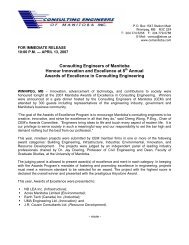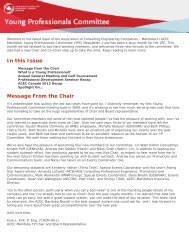Awards of Excellence - ACEC|Manitoba
Awards of Excellence - ACEC|Manitoba
Awards of Excellence - ACEC|Manitoba
You also want an ePaper? Increase the reach of your titles
YUMPU automatically turns print PDFs into web optimized ePapers that Google loves.
2012 <strong>Awards</strong> <strong>of</strong> <strong>Excellence</strong><br />
Award <strong>of</strong> <strong>Excellence</strong> – Infrastructure/Transportation<br />
Project Name: Lake St. Martin Emergency Flood Relief Channel<br />
Final Design & Construction Management<br />
Firm:<br />
AECOM Canada Ltd.<br />
Client: The Province <strong>of</strong> Manitoba<br />
The study Options for Emergency<br />
Reduction <strong>of</strong> Lake Manitoba and<br />
Lake St. Martin Levels was undertaken<br />
by AECOM and KGS Group and<br />
examined a number <strong>of</strong> potential options<br />
for dealing with the 2011 flooding on Lake<br />
St. Martin and Lake Manitoba. This identified<br />
the Dauphin River as the hydraulic<br />
constriction in the system and recommended<br />
the immediate construction <strong>of</strong><br />
an additional emergency channel from<br />
Lake St. Martin to address the hydraulic<br />
flow restrictions in the Dauphin River and<br />
accommodate additional Lake Manitoba<br />
outflows over the winter.<br />
The contract for the detailed design<br />
and construction management <strong>of</strong> the Lake<br />
St. Martin Emergency Outlet Channel<br />
(LSMEOC) was awarded to AECOM in<br />
August <strong>of</strong> 2011. Construction Contracts<br />
with three contractors were signed August<br />
15, 2011.<br />
The objective <strong>of</strong> this project was to<br />
build an emergency outlet channel from<br />
Lake St. Martin to not only provide additional<br />
hydraulic capacity from this lake but<br />
also to allow maximum operation <strong>of</strong> the<br />
Fairford River Control Structure to allow<br />
a more rapid reduction in Lake Manitoba<br />
flood levels. The utility <strong>of</strong> this approach<br />
had been demonstrated during flood<br />
modelling conducted during June <strong>of</strong> 2011<br />
and addressed the concern that actions<br />
taken to lower Lake Manitoba should not<br />
adversely affect Lake St. Martin.<br />
The challenge was to optimise the design<br />
and develop construction plans and a<br />
schedule that would allow the completion<br />
<strong>of</strong> the channel before freeze-up in early<br />
November. Construction <strong>of</strong> the channel<br />
in the time frame available required<br />
optimization <strong>of</strong> the design to provide the<br />
maximum flow rate with the minimum<br />
excavation volume. In addition the design<br />
and staging had to be flexible enough to<br />
be modified to suit the available construction<br />
equipment.<br />
One <strong>of</strong> the many challenges faced was<br />
that the site for the channel was on the<br />
northeast side <strong>of</strong> Lake St. Martin. This site<br />
is remote with no road access. This would<br />
have presented less <strong>of</strong> a problem if construction<br />
could have been delayed until<br />
winter, but the flooding situation on Lake<br />
Manitoba and Lake St. Martin required immediate<br />
action that could not be delayed.<br />
The conditions on the construction<br />
site were also challenging. The ground<br />
page 32 | Manitoba Consulting Engineer<br />
Click Here to return to Table <strong>of</strong> Contents











